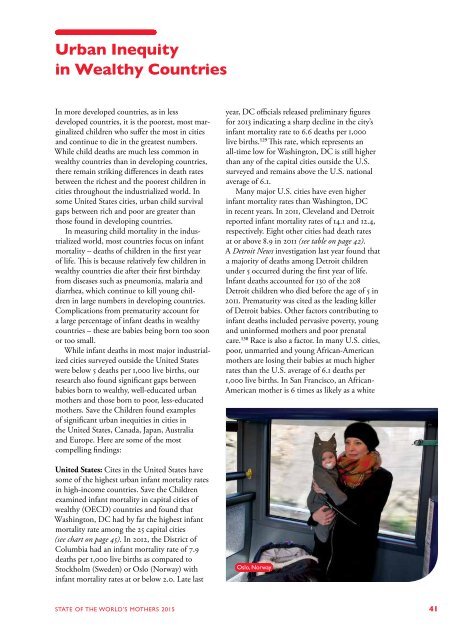sowm_2015__int__africa_full_report_low_res
sowm_2015__int__africa_full_report_low_res
sowm_2015__int__africa_full_report_low_res
You also want an ePaper? Increase the reach of your titles
YUMPU automatically turns print PDFs into web optimized ePapers that Google loves.
Urban Inequity<br />
in Wealthy Countries<br />
In more developed countries, as in less<br />
developed countries, it is the poo<strong>res</strong>t, most marginalized<br />
children who suffer the most in cities<br />
and continue to die in the greatest numbers.<br />
While child deaths are much less common in<br />
wealthy countries than in developing countries,<br />
there remain striking differences in death rates<br />
between the richest and the poo<strong>res</strong>t children in<br />
cities throughout the industrialized world. In<br />
some United States cities, urban child survival<br />
gaps between rich and poor are greater than<br />
those found in developing countries.<br />
In measuring child mortality in the industrialized<br />
world, most countries focus on infant<br />
mortality – deaths of children in the first year<br />
of life. This is because relatively few children in<br />
wealthy countries die after their first birthday<br />
from diseases such as pneumonia, malaria and<br />
diarrhea, which continue to kill young children<br />
in large numbers in developing countries.<br />
Complications from prematurity account for<br />
a large percentage of infant deaths in wealthy<br />
countries – these are babies being born too soon<br />
or too small.<br />
While infant deaths in most major industrialized<br />
cities surveyed outside the United States<br />
were be<strong>low</strong> 5 deaths per 1,000 live births, our<br />
<strong>res</strong>earch also found significant gaps between<br />
babies born to wealthy, well-educated urban<br />
mothers and those born to poor, less-educated<br />
mothers. Save the Children found examples<br />
of significant urban inequities in cities in<br />
the United States, Canada, Japan, Australia<br />
and Europe. Here are some of the most<br />
compelling findings:<br />
United States: Cites in the United States have<br />
some of the highest urban infant mortality rates<br />
in high-income countries. Save the Children<br />
examined infant mortality in capital cities of<br />
wealthy (OECD) countries and found that<br />
Washington, DC had by far the highest infant<br />
mortality rate among the 25 capital cities<br />
(see chart on page 45). In 2012, the District of<br />
Columbia had an infant mortality rate of 7.9<br />
deaths per 1,000 live births as compared to<br />
Stockholm (Sweden) or Oslo (Norway) with<br />
infant mortality rates at or be<strong>low</strong> 2.0. Late last<br />
year, DC officials released preliminary figu<strong>res</strong><br />
for 2013 indicating a sharp decline in the city’s<br />
infant mortality rate to 6.6 deaths per 1,000<br />
live births. 129 This rate, which rep<strong>res</strong>ents an<br />
all-time <strong>low</strong> for Washington, DC is still higher<br />
than any of the capital cities outside the U.S.<br />
surveyed and remains above the U.S. national<br />
average of 6.1.<br />
Many major U.S. cities have even higher<br />
infant mortality rates than Washington, DC<br />
in recent years. In 2011, Cleveland and Detroit<br />
<strong>report</strong>ed infant mortality rates of 14.1 and 12.4,<br />
<strong>res</strong>pectively. Eight other cities had death rates<br />
at or above 8.9 in 2011 (see table on page 42).<br />
A Detroit News investigation last year found that<br />
a majority of deaths among Detroit children<br />
under 5 occurred during the first year of life.<br />
Infant deaths accounted for 130 of the 208<br />
Detroit children who died before the age of 5 in<br />
2011. Prematurity was cited as the leading killer<br />
of Detroit babies. Other factors contributing to<br />
infant deaths included pervasive poverty, young<br />
and uninformed mothers and poor prenatal<br />
care. 130 Race is also a factor. In many U.S. cities,<br />
poor, unmarried and young African-American<br />
mothers are losing their babies at much higher<br />
rates than the U.S. average of 6.1 deaths per<br />
1,000 live births. In San Francisco, an African-<br />
American mother is 6 times as likely as a white<br />
Oslo, Norway<br />
STATE OF THE WORLD’S MOTHERS <strong>2015</strong> 41




